
Oh lexicon, my aim is true.
Over more than fifteen years, I’ve made stuff out of words in many industries, on untold projects, across all manner of surfaces and mediums. I’ve been called lots of things (meaning titles, that is—though I’d imagine light epithets too). A thread has connected it all:
I work to create relatable stories, valuable experiences, and functional frameworks where complex ideas collide.
I’m at my best when approaching work with five big blocks: strategy, structure, systems, standards, and craft. How these operate in a project will vary, but their presence generally won’t—whether I’m building from the ground up, plugging into an existing setup, or just giving the lightest of finishing touches.
I’ll probably never stop rewriting this section. Someday, maybe, I’ll say it exactly right.

So here’s a theory for you.
Content is the substance of communication.

Any piece of content can be weighed by its goal and (intended) response. These depend on purpose and circumstance, and the forces are always in some kind of balance.
Not all of them can be pushed all the way all the time—at least, not any more than you can enter and exit the same room at once. (Though many people, over and over, will deeply believe that you can and request that you absolutely must).

A writer’s got to have a code.
I won’t list here all the guiding principles, content heuristics, success requirements, writing mantras, or editorial approaches that drive my work. Just a few words about words (and more) to explain my brain.
Words mean things.
Something I’ve always loved about working with words is that it’s where hand-waving ends. For a long time in strategy, planning, scoping, mapping, architecting, outlining, drafting, and so on, you can speak in generalities. Final language, however, must be particular and precise. No combinations of arranged words or marks carry exactly the same sense and impression. People are peculiar; their relationship to words is even more so. This is among the many wonderful and exasperating aspects of this kind of work.
Language makes worlds.
It can be easy to think of “style” (surface) and “substance” (essence). So you create a style guide and some voice guidance, then apply it to messaging and research. Easy! But ultimately facile. Language is world-building with words. You’re creating a system that generates meaning; you’re establishing structures that enforce expectations and understanding. Naming requires architecture; terms need taxonomy. Even the most free-wheeling, poetic texts have an underlying apparatus that propels coherence. I like to think of building environments from the ground up—not only painting structures with a soft brush. (This is all as true for visual worlds as verbal ones.)
Stories lead experiences.
We’re all always living out stories—some micro in a single moment, some overarching narratives over long periods of time. So no matter what user, customer, or reader experience we create, someone engaging with a text already has their own path or journey in progress. If we want their attention and engagement, our job is to craft stories so intuitive and engaging that these can meet people where they are and carry them forward. Without this sense of narrative to guide and galvanize, the people on the receiving end of our creations are left to form their own assumptions. They are more likely than not to find an experience fractured, underwhelming—or irrelevant.
Subjects need objects.
When you create, you have unformed intentions to bring to life through cogent artifacts. The cogency has to come to life with the artifact; your subject should befit its object. Plain old written words can do some things particularly well if their container, component, or channel asset is crafted with them in mind. Some ideas are best communicated when led by other means: videos, motion design, icon-based interactions. This may all just be to say that form needs to meet function, or to gesture toward object-oriented UX. But no matter how obvious that feels, it’s a lesson I learn over and over and over again.
These are, I admit, arguably all just variations of the same principle.

← Retreat to Home ∷ Proceed to UX writing & content design →
